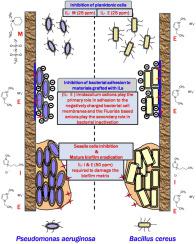当前位置:
X-MOL 学术
›
Anal. Chim. Acta
›
论文详情
Our official English website, www.x-mol.net, welcomes your feedback! (Note: you will need to create a separate account there.)
Efficacy of Imidazolium and Piperidinium based Ionic Liquids on inhibiting biofilm formation on Titanium and Carbon steel surfaces
Analytica Chimica Acta ( IF 6.2 ) Pub Date : 2020-08-01 , DOI: 10.1016/j.aca.2020.05.072 B Anandkumar 1 , R P George 1 , John Philip 2
Analytica Chimica Acta ( IF 6.2 ) Pub Date : 2020-08-01 , DOI: 10.1016/j.aca.2020.05.072 B Anandkumar 1 , R P George 1 , John Philip 2
Affiliation

|
In the present study, the efficacies of three different cationic and anionic ionic liquids (ILs) on biofilm formation on materials used in cooling water systems were evaluated. Two imidazolium based ILs; 1-Ethyl 3-Methylimidazolium tetrafluoroborate - (IL-E) and 1-Butyl-3-methylimidazolium chloride - (IL-I) with anionic fluoride and chloride groups and one piperidinium based IL, N-methyl-N-propylpiperidinium bis(trifluoromethylsulfonyl)imide - (IL-M) with fluoromethyl group as anion were used. The efficacy of these ILs were evaluated on planktonic and sessile cells of major biofilm formers in cooling water systems using Gram negative bacterium Pseudomonas sp. and Gram positive bacterium Bacillus sp. Further their effect on inhibiting biofilm formation on titanium and carbon steel surfaces were also evaluated. Results showed that planktonic cells of Pseudomonas sp. and Bacillus sp. were effectively inhibited by 25 ppm of IL-M and IL-E, respectively. For both bacteria, 50 ppm of IL-I was enough to inhibit and eradicate the sessile cell formation. Among the three ILs, IL-E was the best in inhibiting the adhesion of bacterial cells on Ti and CS surfaces. These results suggest that Imidazolium based ILs are effective in controlling sessile cell formation and eradicating mature biofilm as compared to piperidinium based IL. Further, Imidazolium based IL with fluoride anion (IL-E) was the best in inhibiting adhesion of these bacterial cells and thereby biofilm formation on material surfaces. This study establishes the feasibility of using ILs in cooling water system for bacterial biofilm control along with other conventional biofouling control methods.
中文翻译:

咪唑和哌啶基离子液体抑制钛和碳钢表面生物膜形成的功效
在本研究中,评估了三种不同的阳离子和阴离子离子液体 (IL) 在冷却水系统中使用的材料上形成生物膜的功效。两种咪唑基离子液体;1-乙基 3-甲基咪唑鎓四氟硼酸盐 - (IL-E) 和 1-丁基-3-甲基咪唑鎓氯化物 - (IL-I) 具有阴离子氟化物和氯化物基团和一个基于哌啶鎓的 IL,N-甲基-N-丙基哌啶鎓双(三氟甲基磺酰基) )酰亚胺 - (IL-M) 使用氟甲基作为阴离子。使用革兰氏阴性细菌假单胞菌对冷却水系统中主要生物膜形成剂的浮游和固着细胞评估这些 IL 的功效。和革兰氏阳性菌芽孢杆菌。此外,还评估了它们对抑制钛和碳钢表面生物膜形成的影响。结果表明,假单胞菌属的浮游细胞。和芽孢杆菌。分别被 25 ppm 的 IL-M 和 IL-E 有效抑制。对于这两种细菌,50 ppm 的 IL-1 足以抑制和根除固着细胞的形成。在三种ILs中,IL-E抑制细菌细胞在Ti和CS表面的粘附效果最好。这些结果表明,与基于哌啶的 IL 相比,基于咪唑鎓的 IL 在控制固着细胞形成和根除成熟生物膜方面是有效的。此外,含氟阴离子的咪唑基 IL (IL-E) 在抑制这些细菌细胞的粘附方面是最好的,从而在材料表面形成生物膜。该研究确定了在冷却水系统中使用 IL 进行细菌生物膜控制以及其他常规生物污垢控制方法的可行性。
更新日期:2020-08-01
中文翻译:

咪唑和哌啶基离子液体抑制钛和碳钢表面生物膜形成的功效
在本研究中,评估了三种不同的阳离子和阴离子离子液体 (IL) 在冷却水系统中使用的材料上形成生物膜的功效。两种咪唑基离子液体;1-乙基 3-甲基咪唑鎓四氟硼酸盐 - (IL-E) 和 1-丁基-3-甲基咪唑鎓氯化物 - (IL-I) 具有阴离子氟化物和氯化物基团和一个基于哌啶鎓的 IL,N-甲基-N-丙基哌啶鎓双(三氟甲基磺酰基) )酰亚胺 - (IL-M) 使用氟甲基作为阴离子。使用革兰氏阴性细菌假单胞菌对冷却水系统中主要生物膜形成剂的浮游和固着细胞评估这些 IL 的功效。和革兰氏阳性菌芽孢杆菌。此外,还评估了它们对抑制钛和碳钢表面生物膜形成的影响。结果表明,假单胞菌属的浮游细胞。和芽孢杆菌。分别被 25 ppm 的 IL-M 和 IL-E 有效抑制。对于这两种细菌,50 ppm 的 IL-1 足以抑制和根除固着细胞的形成。在三种ILs中,IL-E抑制细菌细胞在Ti和CS表面的粘附效果最好。这些结果表明,与基于哌啶的 IL 相比,基于咪唑鎓的 IL 在控制固着细胞形成和根除成熟生物膜方面是有效的。此外,含氟阴离子的咪唑基 IL (IL-E) 在抑制这些细菌细胞的粘附方面是最好的,从而在材料表面形成生物膜。该研究确定了在冷却水系统中使用 IL 进行细菌生物膜控制以及其他常规生物污垢控制方法的可行性。



























 京公网安备 11010802027423号
京公网安备 11010802027423号